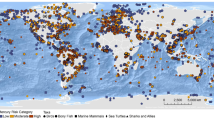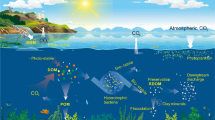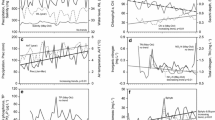Abstract
Anthropogenic mercury accumulation in lake sediments has been studied extensively, but natural processes that controlled mercury accumulation in the past are still poorly understood. We present a 17,300-year record of mercury accumulation in the sediments of Lake Hambre, southernmost Patagonia, Chile (53°S, 70°W), in combination with an investigation of environmental changes in the region. Mercury accumulation in the remote pristine lake varied appreciably, as much as 16×, exceeding the anthropogenic forcing of atmospheric mercury fluxes by a factor of 3–5. Principal Component Analysis revealed that short-term variations were not related to changes in atmospheric mercury deposition or to fluxes of mineral soil into the lake. Instead, there was significant covariation between short-term changes in mercury and catchment-derived trace elements, e.g. copper and yttrium, throughout the past 17,000 years. Covariation between mercury and carbon concentration in some parts of the record suggests that fluxes of particulate and dissolved organic matter from the catchment to the lake account for short-term variations in mercury accumulation. Nevertheless, over the long term, there is no common trend for mercury accumulation and organic matter flux. The median mercury accumulation rate was rather constant (29 μg m−2 a−1), whereas the flux of terrestrial organic matter into the lake increased through time. We hypothesize that this was a consequence of a progressive decrease in the input of terrestrial organic matter-bound mercury through time. Whereas production of terrestrial organic matter increased over the long term because of development of catchment vegetation and soils, following glacier retreat, amounts of mercury, copper and yttrium provided by atmospheric deposition and bedrock weathering remained relatively constant. As a consequence, despite increased fluxes of terrestrial organic matter to the lake, fluxes of mercury remained constant.





Similar content being viewed by others
References
Bentley MJ, McCulloch RD (2005) Impact of neotectonics on the record of glacier and sea level fluctuations, Strait of Magellan, southern Chile. Geogr Ann 87:393–402
Bergkvist B, Folkeson L, Berggren D (1989) Fluxes of Cu, Zn, Pb, Cd, Cr and Ni in temperate forest ecosystems. Water Air Soil Pollut 47:217–286
Biester H, Martinez-Cortizas A, Birkenstock S, Kilian R (2003) Effect of peat decomposition and mass loss on historic mercury records in peat bogs from Patagonia. Environ Sci Technol 37:32–39
Biester H, Bindler R, Martinez-Cortizas A, Engstrom DR (2007) Critical review: modelling the past atmospheric deposition of mercury using natural archives. Environ Sci Technol 41:4851–4860
Cannon WF, Dean WE, Bullock JH Jr (2003) Effects of Holocene climate change on mercury deposition in Elk Lake, Minnesota: the importance of eolian transport in the mercury cycle. Geology 31:187–190
Cheburkin AK, Shotyk W (1996) An Energy-dispersive Miniprobe Multielement Analyzer (EMMA) for direct analysis of Pb and other trace elements in peats. Fresenius’ J Anal Chem 354:688–691
Driscoll CT, Blette V, Yan C, Schofield CL, Munson R, Holsapple J (1995) The role of dissolved organic carbon in the chemistry and bioavailability of mercury in remote Adirondack lakes. Water Air Soil Pollut 80:499–508
Engstrom DR, Fritz SC, Almendinger JE, Juggins S (2000) Chemical and biological trends during lake evolution in recently deglaciated terrain. Nature 408:161–166
Fitzgerald WF, Engstrom DR, Mason RP, Nater EA (1998) The case for atmospheric mercury contamination in remote areas. Environ Sci Technol 32:1–7
Fitzgerald WF, Engstrom DR, Lamborg CH, Tseng C-M, Balcom PH, Hammerschmidt CR (2005) Modern and historic atmospheric mercury fluxes in northern Alaska: global sources and Arctic depletion. Environ Sci Technol 39:557–568
Gälman V, Rydberg J, Sjöstedt de Luna S, Bindler R, Renberg I (2008) Carbon and nitrogen loss rates during aging of lake sediments: changes over 27 years studied in varved lake sediment. Limnol Oceanogr 53:1076–1082
Haraguchi H, Itoh A, Kimata C, Miwa H (1998) Speciation of yttrium and lanthanides in natural water by inductively coupled plasma mass spectrometry after preconcentration by ultrafiltration and with a chelating resin. Analyst 123:773–778
Hare AA, Stern GA, Kuzyk ZZA, Macdonald RW, Johannessen SC, Wang F (2010) Natural and anthropogenic mercury distribution in marine sediments from Hudson Bay, Canada. Environ Sci Technol 44:5805–5811
Hermanns Y-M, Martinez Cortizas A, Arz H, Stein R, Biester H (2012) Untangling the influence of in-lake productivity and terrestrial organic matter fluxes on the accumulation of mercury in pristine Lake Hambre, Patagonia. Submitted to J Paleolimnol
Heusser CJ (1995) Three late quarternary pollen diagrams from Southern Patagonia and their paleoecological implications. Palaeogeogr Palaeoclimatol Palaeoecol 18:1–24
Heusser CJ (1998) Deglacial paleoclimate of the American sector of the Southern Ocean: late Glacial-Holocene records from the latitude of Canal Beagle (55°S), Argentine Tierra del Fuego. Palaeogeogr Palaeoclimatol Palaeoecol 141:277–301
Heusser CL, Heusser LE, Lowell TV, Moreira MA, Moreira MS (2000) Deglacial paleoclimate at Puerto del Hambre, subantarctic Patagonia, Chile. J Quat Sci 15:101–114
Jolliffe IT (2002) Principal Component Analysis. Springer, New York
Kolka RK, Grigal DF, Verry ES, Nater EA (1999a) Mercury and organic carbon relationships in streams draining forested upland/peatland watersheds. J Environ Qual 28:766–775
Kolka RK, Nater EA, Grigal DF, Verry ES (1999b) Atmospheric inputs of mercury and organic carbon into a forested upland/bog watershed. Water Air Soil Pollut 113:273–294
Lamborg CH, Fitzgerald WF, Dammann AWH, Benoit JM, Balcom PH, Engstrom DR (2002) Modern and historic atmospheric mercury fluxes in both Hemispheres: gobal and regional mercury cycling implications. Global Biogeochem Cycles 16:1104–1115
Lamy F, Kilian R, Arz HW, Francois J-P, Kaiser J, Prange M, Steinke T (2010) Holocene changes in the position and intensity of the southern westerly wind belt. Nat Geosci 3:695–699
Lee YH, Bishop KH, Munthe J (2000) Do concepts about catchment cycling of methylmercury and mercury in boreal catchment stand the test of time? Six years of atmospheric inputs and runoff export at Svartberget, northern Sweden. Sci Tot Environ 2060:11–20
Lockhart W, Wilkinson P, Billeck B, Danell R, Hunt R, Brunskill G, Delaronde J, Louis V (1998) Fluxes of mercury to lake sediments in central and northern Canada inferred from dated sediment cores. Biogeochemistry 40:163–173
Magny M, Haas JN (2004) A major widespread climatic change around 5,300 cal. yr BP at the time of the Alpine Iceman. J Quat Sci 19:423–430
Markgraf V (1993) Paleoenvironments and paleoclimates in Tierra del Fuego and southernmost Patagonia, South America. Palaeogeogr Palaeoclimatol Palaeoecol 102:53–68
Markgraf V, Bradbury JP, Schwalb A, Burns SJ, Stern C, Ariztegui D, Gili A, Anselmetti FS, Stine S, Maidana N (2003) Holocene paleo-climates of Southern Patagonia: limnological and environmental history of Lago Cardiel, Argentina. Holocene 13:581–591
McCormac FG, Hogg AG, Blackwell PG, Buck CE, Higham TFG, Reimer PJ (2004) SHCal04 southern hemisphere calibration 0–11.0 cal kyr BP. Radiocarbon 46:1087–1092
McCulloch RD, Davies SJ (2001) Late glacial and Holocene paleoenvironmental changes in the central Strait of Magellan, southern Patagonia. Palaeogeogr Palaeoclimatol Palaeoecol 173:143–173
McCulloch RD, Bentley MJ, Purves RS, Hulton NRJ, Sugden DE, Clapperton CM (2000) Climatic inferences from glacial and paleoecological evidence at the last glacial termination, southern South America. J Quat Sci 15:409–417
Meili M (1991) The coupling of mercury and organic matter in the biogeochemical cycle—towards a mechanistic model for the boreal forest zone. Water Air Soil Pollut 56:333–347
Meyers PA, Lallier-Vergès E (1999) Lacustrine sedimentary organic matter records of Late Quarternary paleoclimates. J Paleolim 21:345–372
Meyers PA, Leenheer MJ, Bourbonniere RA (1995) Diagenesis of vascular plant organic matter components during sediment burial. Aquat Geochem 1:35–52
Moy CM, Dunbar RB, Guilderson TP, Waldmann N, Mucciarone DA, Recasens C, Ariztegui D, Austin JA Jr, Anselmetti FS (2011) A geochemical and sedimentary record of high southern latitude Holocene climate evolution from Lago Fagnano, Tierra del Fuego. Earth Planet Sci Lett 302:1–3
Murad E (1978) Yttrium and Zirconium as geochemical guide elements in soil and stream sediment sequences. J Soil Sci 29:219–223
Nriagu J, Becker C (2003) Volcanic emissions of mercury to the atmosphere: global and regional inventories. Sci Tot Environ 304:3–12
Ouellet JF, Lucotte M, Teisserenc R, Paquet S, Canuel R (2009) Lignin biomarkers as tracers of mercury sources in lakes water column. Biogeochemistry 94:123–140
Outridge PM, Sanei H, Stern GA, Hamilton PB, Goodarzi F (2007) Evidence for control of mercury accumulation rates in Canadian high arctic lake sediments by variations of aquatic primary productivity. Environ Sci Technol 41:5259–5265
Perdue EM, Koprivnjak JF (2007) Using the C/N ratio to estimate terrigenous inputs of organic matter to aquatic environments. Est Coast Sh Sci 73:65–72
Phillips VJA, St Louis VL, Cooke CA, Vinebrooke RD, Hobbs WO (2011) Increased mercury loadings to western Canadian Alpine lakes over the past 150 years. Environ Sci Technol 45:2042–2047
Regnell O, Watras CJ, Troedsson B, Helgee A, Hammar T (2009) Mercury in a boreal forest stream – role of historical mercury pollution, TOC, temperature and water discharge. Environ Sci Technol 43:3514–3521
Reimer PJ, Baillie MGL, Bard E, Bayliss A, Beck JW, Bertrand CJH, Blackwell PG, Buck CE, Burr GS, Cutler KB, Damon PE, Edwards RL, Fairbanks RG, Friedrich M, Guilderson TP, Hogg AG, Hughen KA, Kromer B, McCormac G, Manning S, Ramsey CB, Reimer RW, Remmele S, Southon JR, Stuiver M, Talamo S, Taylor FW, Van Der Plicht J, Weyhenmeyer CE (2004) IntCal04 terrestrial radiocarbon age calibration, 0–26 cal kyr BP. Radiocarbon 46:1029–1058
Ribeiro Guevara S, Meili M, Rizzo A, Daga R, Arribére M (2010) Sediment records of highly variable mercury inputs to mountain lakes in Patagonia during the past millennium. Atmos Chem Phys 10:3443–3453
Selin NE, Jacob DJ, Yantosca RM, Strode S, Jaeglé L, Sunderland EM (2008) Global 3-D land-ocean-atmosphere model for mercury: present-day versus preindustrial cycles and anthropogenic enrichment factors for deposition. Global Biogeochem Cycles 22:1–13
Stern CR (2008) Holocene tephrochronology record of large explosive eruptions in the southernmost Patagonian Andes. Bull Volcanol 70:435–454
Stern GA, Sanei H, Roach P, Delaronde J, Outridge PM (2009) Historical interrelated variations of mercury and aquatic organic matter in lake sediment cores from a subarctic lake in Yukon, Canada: further evidence toward the algal-mercury scavenging hypothesis. Environ Sci Technol 43:7684–7690
Teisserenc R, Lucotte M, Houel S (2010) Terrestrial organic matter biomarkers as tracers of Hg sources in lake sediments. Biogeochemistry 103:235–244
Thompson LG, Mosley-Thompson E, Brecher H, Davis M, León B, Les D, Lin PN, Mashiotta T, Mountain K (2006) Abrupt tropical climate changes: past and present. PNAS 103:10536–10543
Vandal GM, Fitzgerald WF, Boutron CF, Candelone JR (1993) Variations in mercury deposition to Antarctica over the past 34,000 years. Nature 362:621–623
Villa-Martínez R, Moreno PI (2007) Pollen evidence for variations in the southern margin of the westerly winds in SW Patagonia over the last 12,600 years. Quat Res 68:400–409
Waldmann N, Anselmetti FS, Ariztegui D, Austin JA Jr, Pirouz M, Moy CM, Dunbar R (2010) Holocene mass-wasting events in Lago Fagnano, Tierra del Fuego (54°S): implications for paleoseismicity of the Magellanes-Fagnano transform fault. Basin Res 23:171–190
Yang H, Engstrom DR, Rose NL (2010) Recent changes in atmospheric mercury deposition recorded in the sediments of remote equatorial lakes in the Rwenzori Mountains, Uganda. Environ Sci Technol 44:6570–6575
Acknowledgments
We thank the German Science Foundation (DFG) for funding to H. Biester (BI 734/10-1). We are grateful to R. Kilian, H. Arz and J. Kaiser for providing the sediment core and support during sample preparation. We thank C. Rios Cardoza (Instituto de la Patagonia, Universidad de Magellanes) and P. Cid-Agüero (Dirección de Programas Antárticos, Universidad de Magallanes) for support during the field campaigns.
Author information
Authors and Affiliations
Corresponding author
Electronic supplementary material
Below is the link to the electronic supplementary material.
Rights and permissions
About this article
Cite this article
Hermanns, YM., Biester, H. A 17,300-year record of mercury accumulation in a pristine lake in southern Chile. J Paleolimnol 49, 547–561 (2013). https://doi.org/10.1007/s10933-012-9668-4
Received:
Accepted:
Published:
Issue Date:
DOI: https://doi.org/10.1007/s10933-012-9668-4




